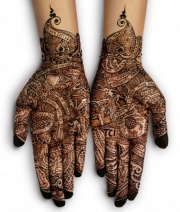Henna Tattoo
Henna is a flowering plant. The name henna also refers to the dye prepared from the plant and the art of temporary tattooing based on those dyes. Henna has been used since antiquity to dye skin, hair, and fingernails, as well as fabrics including silk, wool, and leather. The name is used in other skin and hair dyes, such as black henna and neutral henna, neither of which are derived from the henna plant.
Historically, henna was used for cosmetic purposes in the Roman Empire, Convivencia-period Iberia and Ancient Egypt, as well as other parts of North Africa, the Horn of Africa, the Arabian Peninsula, the Near East and South Asia. It was also popular among women in 19th-century Europe. Today, bridal henna nights remain an important tradition in many of these areas.
Temporary Body Art
Henna has been used to adorn young women's bodies as part of social and holiday celebrations since the late Bronze Age in the eastern Mediterranean. The earliest text mentioning henna in the context of marriage and fertility celebrations comes from the Ugaritic legend of Baal and Anath, which has references to women marking themselves with henna in preparation to meet their husbands, and Anath adorning herself with henna to celebrate a victory over the enemies of Baal.
The Night of the Henna was celebrated by most groups in the areas where henna grew naturally: Jews, Muslims, Sikhs, Hindus, Christians and Zoroastrians, among others, all celebrated marriages by adorning the bride, and often the groom, with henna. Across the henna-growing region, Purim, Eid, Diwali, Karva Chauth, Passover, Nowruz, Mawlid, and most saints' days were celebrated with some henna.
Henna was regarded as having blessings, and was applied for luck as well as joy and beauty. Brides typically had the most henna, and the most complex patterns, to support their greatest joy, and wishes for luck. Some bridal traditions were very complex, such as those in Yemen, where the Jewish bridal henna process took four or five days to complete, with multiple applications and resist work.
The fashion of "Bridal Mehndi" in Pakistan, Northern Libya and in North Indian diasporas is currently growing in complexity and elaboration, with new innovations in glitter, gilding, and fine-line work. Recent technological innovations in grinding, sifting, temperature control, and packaging henna, as well as government encouragement for henna cultivation, have improved dye content and artistic potential for henna. [1]
Risks
Henna is known to be dangerous to people with glucose-6-phosphate dehydrogenase deficiency (G6PD deficiency), which is more common in males than females. Infants and children of particular ethnic groups are especially vulnerable. Though user accounts cite few other negative effects of natural henna paste, save for occasional allergic reactions, pre-mixed henna body art pastes may have ingredients added to darken stain, or to alter stain color. The health risks involved in pre-mixed paste can be significant. The United States Food and Drug Administration (FDA) does consider these risks to be adulterants and therefore illegal for use on skin. Some pastes have been noted to include: silver nitrate, carmine, pyrogallol, disperse orange dye, and chromium. These have been found to cause allergic reactions, chronic inflammatory reactions, or late-onset allergic reactions to hairdressing products and textile dyes.
Black henna" powder may be derived from indigo (from the plant Indigofera tinctoria). It may also contain unlisted dyes and chemicals. "Black henna" may contain p-phenylenediamine (PPD), which can stain skin black quickly, but can cause severe allergic reactions and permanent scarring. The FDA specifically forbids PPD to be used for that purpose, and may prosecute those who produce "black henna'. Artists who injure clients with "Black Henna" in the U.S. may be sued for damages. [2]
